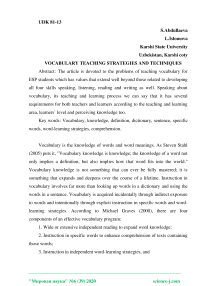Vocabulary teaching strategies and techniques
Автор: Abdullaeva S., Islomova L.
Журнал: Мировая наука @science-j
Рубрика: Основной раздел
Статья в выпуске: 6 (39), 2020 года.
Бесплатный доступ
The article is devoted to the problems of teaching vocabulary for ESP students which has values that extend well beyond those related to developing all four skills speaking, listening, reading and writing as well. Speaking about vocabulary, its teaching and learning process we can say that it has several requirements for both teachers and learners according to the teaching and learning area, learners` level and perceiving knowledge too.
Vocabulary, knowledge, definition, dictionary, sentence, specific words, word-learning strategies, comprehension
Короткий адрес: https://sciup.org/140265679
IDR: 140265679 | УДК: 81-13
Текст научной статьи Vocabulary teaching strategies and techniques
Vocabulary is the knowledge of words and word meanings. As Steven Stahl (2005) puts it, "Vocabulary knowledge is knowledge; the knowledge of a word not only implies a definition, but also implies how that word fits into the world." Vocabulary knowledge is not something that can ever be fully mastered; it is something that expands and deepens over the course of a lifetime. Instruction in vocabulary involves far more than looking up words in a dictionary and using the words in a sentence. Vocabulary is acquired incidentally through indirect exposure to words and intentionally through explicit instruction in specific words and wordlearning strategies. According to Michael Graves (2000), there are four components of an effective vocabulary program:
-
1. Wide or extensive independent reading to expand word knowledge;
-
2. Instruction in specific words to enhance comprehension of texts containing those words;
-
3. Instruction in independent word-learning strategies, and
-
4. Word consciousness and word-play activities to motivate and enhance learning.
The National Reading Panel (2000) concluded that there is no single researchbased method for teaching vocabulary. From its analysis, the panel recommended using a variety of direct and indirect methods of vocabulary instruction.
Word-Learning Strategies
-
□ Dictionary Use
-
□ Morphemic Analysis
-
□ Cognate Awareness (ELL)
-
□ Contextual Analysis
According to the National Reading Panel (2000), explicit instruction of vocabulary is highly effective. To develop vocabulary intentionally, students should be explicitly taught both specific words and word-learning strategies. To deepen students' knowledge of word meanings, specific word instruction should be robust (Beck et al., 2002). Seeing vocabulary in rich contexts provided by authentic texts, rather than in isolated vocabulary drills, produces robust vocabulary learning (National Reading Panel, 2000). Such instruction often does not begin with a definition, for the ability to give a definition is often the result of knowing what the word means. Rich and robust vocabulary instruction goes beyond definitional knowledge; it gets students actively engaged in using and thinking about word meanings and in creating relationships among words.
Research shows that there are more words to be learned than can be directly taught in even the most ambitious program of vocabulary instruction. Explicit instruction in word-learning strategies gives students tools for independently determining the meanings of unfamiliar words that have not been explicitly introduced in class. Since students encounterso many unfamiliar words in their reading, any help provided by such strategies can be useful.
Word-learning strategies include dictionary use, morphemic analysis, and contextual analysis. Dictionary use teaches students about multiple word meanings, as well as the importance of choosing the appropriate definition to fit the particular context. Morphemic analysis is the process of deriving a word's meaning by analyzing its meaningful parts, or morphemes. Such word parts include root words, prefixes, and suffixes. Contextual analysis involves inferring the meaning of an unfamiliar word by scrutinizing the text surrounding it. Instruction in contextual analysis generally involves teaching students to employ both generic and specific types of context clues.
A more general way to help students develop vocabulary is by fostering word consciousness, an awareness of and interest in words. Word consciousness is not an isolated component of vocabulary instruction; it needs to be taken into account each and every day (Scott and Nagy, 2004). It can be developed at all times and in several ways: through encouraging adept diction, through word play, and through research on word origins or histories. According to Graves (2000), "If we can get students interested in playing with words and language, then we are at least halfway to the goal of creating the sort of word-conscious students who will make words a lifetime interest."
One principle of effective vocabulary learning is to provide multiple exposures to a word's meaning. There is great improvement in vocabulary when students encounter vocabulary words often (National Reading Panel, 2000). According to Stahl (2005), students probably have to see a word more than once to place it firmly in their long-term memories. "This does not mean mere repetition or drill of the word," but seeing the word in different and multiple contexts. In other words, it is important that vocabulary instruction provide students with opportunities to encounter words repeatedly and in more than one context.
Список литературы Vocabulary teaching strategies and techniques
- Saville-Troike M. (2006). Introducing Second Language Acquisition. Cambridge.
- Sifakis N. (2003). Applying the adult education framework to ESP curriculum.


